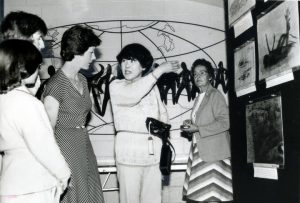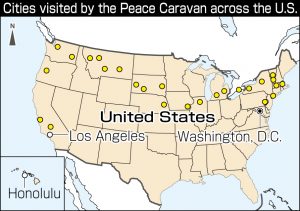HAC’s passion 50 years ago for imparting information on A-bombed Hiroshima, Part 2: Peace caravan traveled across U.S. with “A-bomb drawings”
Jul. 26, 2023
Sharing A-bombing experience in tour of 29 cities
by Hiromi Morita, Staff Writer
“I hope people consider the bombing as something that could happen tomorrow rather than as only something from 37 years ago,” said Miyoko Matsubara, an A-bomb survivor who died in 2018, in remarks she made when she was sent by the Hiroshima Appeal Committee (HAC) to the anti-nuclear Peace Caravan that traversed the United States in 1982. A handwritten manuscript of the speech remains today at the World Friendship Center (WFC), an NPO in Hiroshima’s Nishi Ward.
Her writing illuminates the passion she had for communicating an anti-nuclear message during her lifetime. That time, the Cold War period, was marked by a fierce nuclear arms race between the United States and the Soviet Union. Anti-nuclear citizen movements gained unprecedented momentum to resist the deployment of nuclear weapons in Europe. That same year, the UN second special session devoted to disarmament was scheduled to be held in New York City.
Anti-nuclear rallies held in various places
The HAC planned to send Ms. Matsubara on the caravan with the aim of enhancing anti-nuclear sentiment among the public in the United States. During the course of about two months, she visited 29 cities in North America in a van together with Barbara Reynolds and a former director of the WFC, taking part in nearly 70 rallies. With the the “A-bomb drawings” she had taken with her and slide presentation she had made for the occasion, she spoke of her passion for the elimination of nuclear weapons to crowds totaling around 110,000 people. The Chugoku Shimbun reported at that time about Ms. Matsubara’s appearance on a radio show in the state of New York, in which she spoke of her determination to continue the trip devoted to peace after she herself had undergone 10 surgeries for the treatment of keloids.
At the age of 14, Ms. Matsubara experienced the atomic bombing about 1.5 kilometers from the hypocenter, suffering severe burns over her entire body including her face. With help from high-profile individuals such as a well-known author, she underwent skin-graft surgeries in 1952. In 1962 and 1964, she participated in the World Peace Pilgrimage, a project championed by Barbara Reynolds. The two continued their collaboration on anti-nuclear peace activities. Ms. Matsubara became a staff member at the Hiroshima Peace Culture Foundation and also managed HAC’s administrative work.
In fact, Ms. Matsubara’s detail-oriented nature greatly contributed to the recent discovery of the HAC-related materials. Inside files, she placed notes describing how the HAC had been formed and its activities after establishment, the group’s accounting reports, business reports, and correspondences. She also left behind clean copies of lists and summaries of A-bomb publications that had been sent to the United States.
She seemed to have particularly strong feelings for the Peace Caravan initiative. She kept a large number of correspondences that had been exchanged with Ms. Reynolds and other people concerned before the caravan trip, in a file titled “U.S. A-bomb drawing exhibit.” The correspondences reveal the work that took place until her departure for the United States.
In a letter from Ms. Reynolds dated May 7, 1981, in response to a previous letter from Ms. Matsubara that had reported her plan to visit the United States, Ms. Reynolds wrote that the A-bomb drawings should be seen by many people because the images could move people to action. Ms. Reynold’s letter requested Ms. Matsubara’s concrete ideas about activities to ensure the exhibit’s success.
That was an era without email or smart phones. There remains the rough draft of a letter written by Ms. Matsubara apologizing for a late response. There are also letters from the two women that seem to have been written on the same day and crossed in the mail. The letters give a sense of how hard the two had worked to craft a detailed plan at a time when communication was not fast or easy. Also discovered was that the caravan’s timing had been postponed from the original plan for the fall of 1981 to the spring of the next year due to the local areas’ capacity to host the caravan.
Many reports also found
Many documents reported on the caravan. The reports carry such information as the cities the caravan visited, the dates and times of gatherings, and the numbers of attendees. The reports also show that many people had implored the caravan to visit the Soviet Union and that Pearl Harbor had been raised as a counter to the atomic bombing. Ms. Matsubara also wrote, “The general public’s awareness about nuclear weapons is scant. The voices of those who advocate nuclear deterrence is still dominant. I have to continue communicating the ‘heart of Hiroshima.’” With that, Ms. Matsubara continued to share her experience in the atomic bombing with people around the world for the rest of her life.
“I supported her from behind the scenes,” said Hiromu Morishita, an honorary chair at WFC who had known Ms. Matsubara since the time he joined the World Peace Pilgrimage in 1964. Resulting from his visit to the United States at that time, Mr. Morishita believes the power of grass-root efforts might be small but the spontaneous energy generated is powerful and grows.
(Originally published on July 26, 2023)









